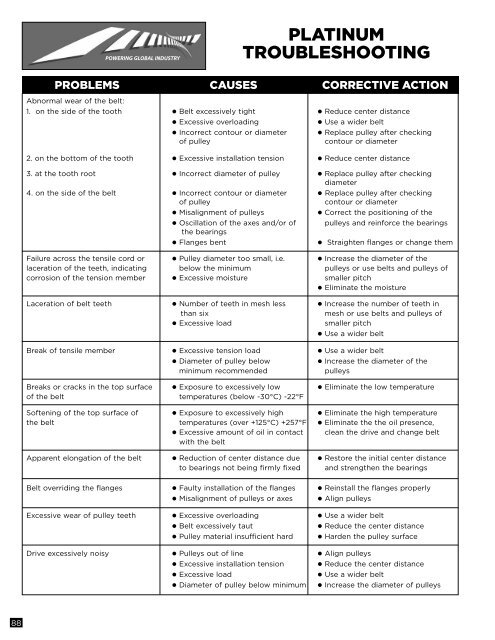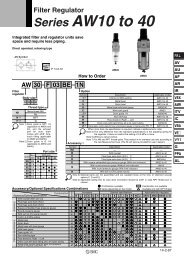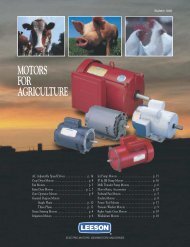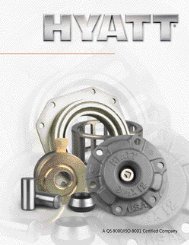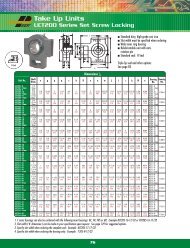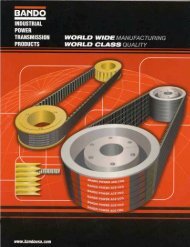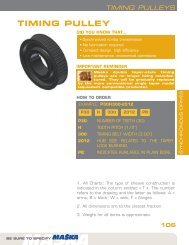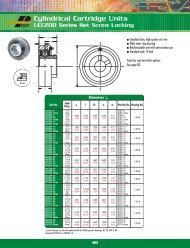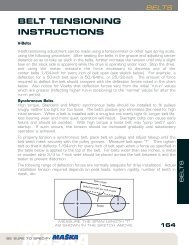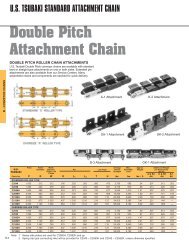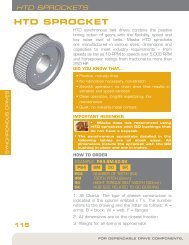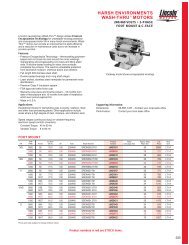Platinum Belt Design Manual - Jason Industrial
Platinum Belt Design Manual - Jason Industrial
Platinum Belt Design Manual - Jason Industrial
Create successful ePaper yourself
Turn your PDF publications into a flip-book with our unique Google optimized e-Paper software.
POWERING GLOBAL INDUSTRY<br />
PLATINUM<br />
TROUBLESHOOTING<br />
PROBLEMS CAUSES CORRECTIVE ACTION<br />
Abnormal wear of the belt:<br />
1. on the side of the tooth • <strong>Belt</strong> excessively tight • Reduce center distance<br />
• Excessive overloading<br />
• Use a wider belt<br />
• Incorrect contour or diameter • Replace pulley after checking<br />
of pulley<br />
contour or diameter<br />
2. on the bottom of the tooth • Excessive installation tension • Reduce center distance<br />
3. at the tooth root • Incorrect diameter of pulley • Replace pulley after checking<br />
diameter<br />
4. on the side of the belt • Incorrect contour or diameter • Replace pulley after checking<br />
of pulley<br />
contour or diameter<br />
• Misalignment of pulleys<br />
• Correct the positioning of the<br />
• Oscillation of the axes and/or of pulleys and reinforce the bearings<br />
the bearings<br />
• Flanges bent<br />
• Straighten flanges or change them<br />
Failure across the tensile cord or • Pulley diameter too small, i.e. • Increase the diameter of the<br />
laceration of the teeth, indicating below the minimum pulleys or use belts and pulleys of<br />
corrosion of the tension member • Excessive moisture smaller pitch<br />
• Eliminate the moisture<br />
Laceration of belt teeth • Number of teeth in mesh less • Increase the number of teeth in<br />
than six<br />
mesh or use belts and pulleys of<br />
• Excessive load<br />
smaller pitch<br />
• Use a wider belt<br />
Break of tensile member • Excessive tension load • Use a wider belt<br />
• Diameter of pulley below<br />
• Increase the diameter of the<br />
minimum recommended<br />
pulleys<br />
Breaks or cracks in the top surface • Exposure to excessively low • Eliminate the low temperature<br />
of the belt<br />
temperatures (below -30°C) -22°F<br />
Softening of the top surface of • Exposure to excessively high • Eliminate the high temperature<br />
the belt temperatures (over +125°C) +257°F • Eliminate the the oil presence,<br />
• Excessive amount of oil in contact clean the drive and change belt<br />
with the belt<br />
Apparent elongation of the belt • Reduction of center distance due • Restore the initial center distance<br />
to bearings not being firmly fixed and strengthen the bearings<br />
<strong>Belt</strong> overriding the flanges • Faulty installation of the flanges • Reinstall the flanges properly<br />
• Misalignment of pulleys or axes • Align pulleys<br />
Excessive wear of pulley teeth • Excessive overloading • Use a wider belt<br />
• <strong>Belt</strong> excessively taut<br />
• Reduce the center distance<br />
• Pulley material insufficient hard • Harden the pulley surface<br />
Drive excessively noisy • Pulleys out of line • Align pulleys<br />
• Excessive installation tension<br />
• Reduce the center distance<br />
• Excessive load<br />
• Use a wider belt<br />
• Diameter of pulley below minimum • Increase the diameter of pulleys<br />
88


